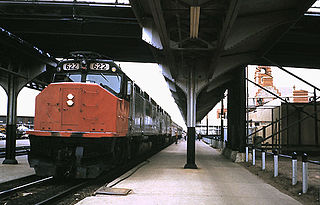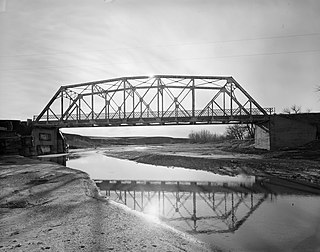
Bent's Old Fort is an 1833 fort located in Otero County in southeastern Colorado, United States. A company owned by Charles Bent and William Bent and Ceran St. Vrain built the fort to trade with Southern Cheyenne and Arapaho Plains Indians and trappers for buffalo robes. For much of its 16-year history, the fort was the only major white American permanent settlement on the Santa Fe Trail between Missouri and the Mexican settlements. It was destroyed in 1849.

The Cheyenne Depot Museum is a railroad museum in Cheyenne, Wyoming, United States. It is located inside the 1880s Union Pacific Railroad depot. A National Historic Landmark, the station was the railroad's largest west of Council Bluffs, Iowa, and a major western example of Richardsonian Romanesque architecture.
The Wyoming Governor's Mansion is the official residence of the governor of Wyoming. The current mansion was built during 1976 in Cheyenne.

The DSD Bridge across the Cheyenne River in Wyoming is a single-span truss bridge built circa 1915. The steel seven-panel Pennsylvania truss spans 130.67 feet (39.83 m) on Niobrara County Road CN14-46. It was placed on the National Register of Historic Places as part of a thematic study of Wyoming river crossings in 1985.

The Rawhide Buttes Stage Station, the Running Water Stage Station and the Cheyenne–Black Hills Stage Route comprise a historic district that commemorates the stage coach route between Cheyenne, Wyoming, and Deadwood, South Dakota. The route operated beginning in 1876, during the height of the Black Hills Gold Rush, and was replaced in 1887 by a railroad.

The Cheyenne County Courthouse in Cheyenne Wells, Colorado is a Georgian Revival-style building that was built in 1908 and first used in 1909. It was listed on the National Register of Historic Places in 1989.

The Dull Knife Battlefield is located on the eastern slope of the Bighorn Mountains in Johnson County, Wyoming near Kaycee. It was the scene of the Dull Knife Fight on November 25, 1876, in which the Fourth Cavalry under General Ranald S. Mackenzie raided the winter encampment of the NorthernCheyenne, destroying most of their material culture and all their winter supplies and thus forcing the Northern Cheyenne to seek shelter with the village of Crazy Horse in order to survive the winter. Five hundred ponies were captured and about 173 lodges destroyed. The Dull Knife battlefield is on private land and is available to visit only by special arrangement. The fight took place on November 25, 1876.

The Second Rindge Meetinghouse, Horsesheds and Cemetery is a historic meeting house and cemetery on Old US 202 and Rindge Common in Rindge, New Hampshire. Built in 1796, it is relatively distinctive in New England as one of few such meeting houses where both civic and religious functions are still accommodated, housing both the town offices and a church congregation. The town's first cemetery, established in 1764, lies to the north of the meetinghouse. It is the resting place of many of Rindge's early settlers, and of its American Revolutionary War veterans. Behind the meetinghouse stand a row of horse sheds, the only one of the two rows of them which originally served the meetinghouse. The property was listed on the National Register of Historic Places in 1979.

First United Methodist Church is a historic Methodist church building at the northeast corner of 18th Street and Central Avenue in Cheyenne, Wyoming, United States.

St. Mary's Cathedral is the cathedral and parish church in the Diocese of Cheyenne located in Cheyenne, Wyoming, United States. It was listed on the National Register of Historic Places in 1974.

The Rainsford Historic District in Cheyenne, Wyoming comprises a group of Victorian houses, many designed by architect George D. Rainsford. The neighborhood includes the residences of a number of cattle barons, giving rise to the name "Cattle Baron Row." The district is located immediately to the east of downtown Cheyenne and includes examples of Stick, Eastlake, Greek Revival, Romanesque Revival and Shingle style architecture, among other eclectic styles of the time. The neighborhood includes the former Wyoming Governor's Mansion and the William Sturgis House, both individually listed on the National Register of Historic Places.

Nagle Warren Mansion, also known as Cheyenne YWCA Building, is former residence and YWCA with three buildings located in Cheyenne, Laramie County, Wyoming. The mansion is on the edge of Cheyenne's historic downtown section on Cattle Barons’ Row. It operated as a bed and breakfast ("B&B") establishment since 1997 with twelve guest rooms decorated in Victorian West style. One guest room is a suite and each room has its own bath. Six rooms are in the main house and six in the carriage house. There are three conference rooms. The B&B had an AAA four-diamond rating. Furnishings and decorations are authentic to the period of the American Old West and include furniture; wallpaper; brass, marble, bronze, or gas fireplaces; ornate staircases; cherry, mahogany, and oak woodwork; and stained glass windows, as well as some Moorish tile and a Moroccan chandelier. In 2019 it became a private residence.

The Atlas Theatre, also known as the Atlas Building, at 213 W. 16th St. in Cheyenne, Wyoming, was dating from 1887 and was built out as a theatre in 1908. It was listed on the National Register of Historic Places in 1973.

The Cheyenne County Jail, at 85 W. Second St. in Cheyenne Wells, Colorado, was built in 1894. It was a work of Denver architect Robert S. Roeschlaub with some Romanesque Revival styling. It is now operated as the Cheyenne Wells Old Jail Museum. It was listed on the National Register of Historic Places in 1988.

The Downtown Cheyenne Historic District in Cheyenne, Wyoming is a historic district that was listed on the National Register of Historic Places in 1978. It is an area of about seven blocks, in the core of the original business district of Cheyenne, and home of many of the first masonry commercial buildings in Cheyenne.

The Cheyenne High School at 2810 House Avenue in Cheyenne, Wyoming is a Late Gothic Revival-style building which was built in 1921. It has also been known as Central High School and as Laramie County School District No.1 Administration Building and was listed on the National Register of Historic Places in 2005.

The Federal Office Building-Cheyenne, at 308 W. 21st St. in Cheyenne, Wyoming, is a Classical Revival-style building built in 1932. It was listed on the National Register of Historic Places in 2000.

The Ferdinand Lafrentz House, at 2015 Warren Ave. in Cheyenne, Wyoming, was built in 1882. It was listed on the National Register of Historic Places in 1979.

The Whipple-Lacey House, at 300 E. 17th St. in Cheyenne, Wyoming, was built in 1883. It was listed on the National Register of Historic Places in 1980.
The Dorroh-Trent House, at 11th and Conley Streets in Hammon, Oklahoma, was built in 1910. It was listed on the National Register of Historic Places in 1979.




















